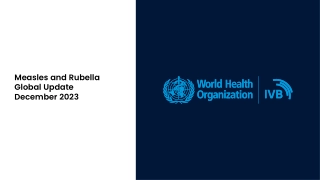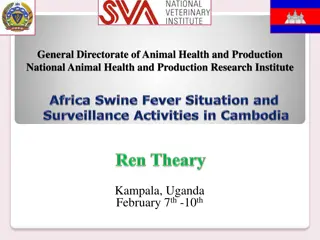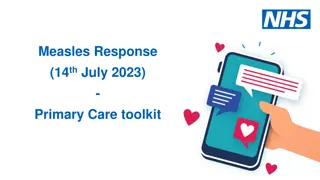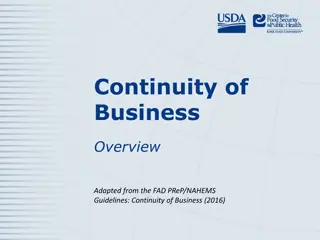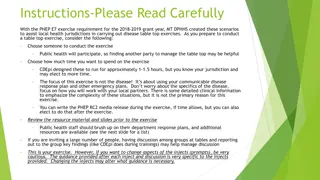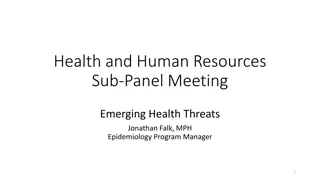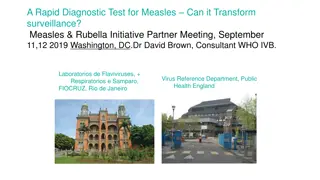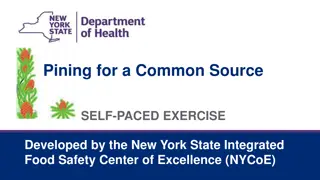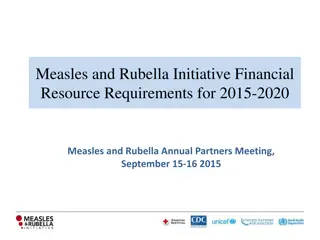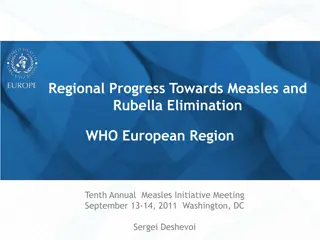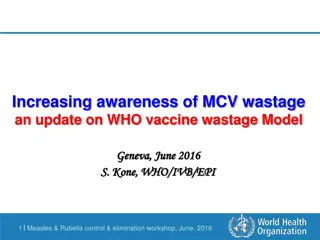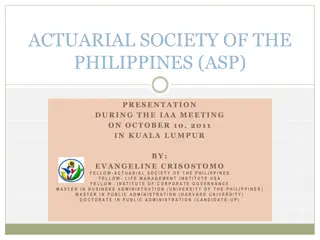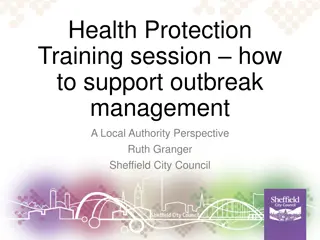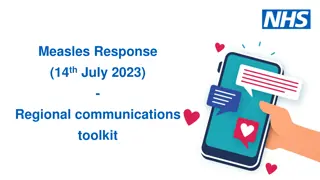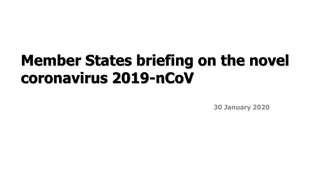Strategies for Overcoming Surveillance Challenges During the 2014 Measles Outbreak in the Philippines
The Philippines faced surveillance challenges during the 2014 measles outbreak, including manpower capacity, logistics, data management, and reporting mechanisms. Key interventions involved activating surge capacity, conducting orientations, procuring specimen kits, and promoting efficient data collection. Emphasizing epi-linking and strategic laboratory confirmation process were essential for maintaining surveillance functionality.
Download Presentation

Please find below an Image/Link to download the presentation.
The content on the website is provided AS IS for your information and personal use only. It may not be sold, licensed, or shared on other websites without obtaining consent from the author.If you encounter any issues during the download, it is possible that the publisher has removed the file from their server.
You are allowed to download the files provided on this website for personal or commercial use, subject to the condition that they are used lawfully. All files are the property of their respective owners.
The content on the website is provided AS IS for your information and personal use only. It may not be sold, licensed, or shared on other websites without obtaining consent from the author.
E N D
Presentation Transcript
HOW THE PHILIPPINES OVERCOME THE SURVEILLANCE CHALLENGES ELICITED BY THE 2014 MEASLES OUTBREAK MARIA WILDA T. SILVA, MD DEPARTMENT OF HEALTH PHILIPPINES
MEASLES CASES BY MONTH OF RASH ONSET 2010 - 2015 18000 16000 14000 12000 No. ofMeasles Cases 10000 8000 6000 2011 SIA, 9-95M (84%) 2014 SIA, 9-59M (91%) 4000 2000 0 2010 2011 2012 2013 2014 2015 Lab = 3239 Epi = 171 Compatible = 3144 Lab = 2870 Epi = 137 Compatible = 3361 Lab = 3207 Epi = 504 Compatible = 2017 Lab = 13339 Lab = 660 Epi = 37 Compatible = 831 Epi = 10404 Compatible= 30963 Laboratory-confirmed Epidemiologically-confirmed Measles Compatible Source: Epidemiology Bureau
CONFIRMED MEASLES CASES 2013 - 2015
SURVEILLANCE CHALLENGES 2014 MEASLES OUTBREAK
KEY SURVEILLANCE CHALLENGES 1. Manpower capacity 2. Adequacy of supply and logistics 3. Quality of Data management 4. Reporting and feedback mechanism
KEY INTERVENTIONS TO MAINTAIN SURVEILLANCE FUNCTIONALITY Surge capacity was activated after the Secretary of Health officially acknowledge the outbreak, Many regions conducted refresher orientation on measles surveillance and outbreak response for DSO, DSC and LGUs DOH EB and WHO did emergency procurement of additional supply of specimen collection kits for measles investigation To overcome collection and transport issues, promoted collection of DBS instead of whole blood in areas with difficulty The DOH EB and NML regulated the allocation of specimen collection kits (limit to 5 per region per week) DOH EB promoted epi-linking of cases in areas with documented lab- confirmed cases
KEY INTERVENTIONS TO MAINTAIN SURVEILLANCE FUNCTIONALITY DOH EB issued a released AO for strengthening laboratory confirmation for measles surveillance The DOH EB and NML developed a more strategic approach to case/outbreak confirmation that will prevent confusion in specimen collection particularly when the outbreak is over. WHO provided data management support to SLH and DOH EB for data encoding, consolidation, analysis, epi-linking, mapping, report generation, etc. DOH EB also came up with an AO providing guidance for LGUs in responding to measles outbreak, including epi-linking of case in areas with laboratory confirmed measles
EPI LINKING COMPATIBLE CASES WITH LAB-CONFIRMED CASES Even in January, when specimen referrals sharply rose and blood collection kits are running out, the system resorted to DBS collection more than epi-linking of cases. When the lab ran out of test kit in February and unable to test more than 10,000 samples taken from suspect measles, epi-linking has become more critical. It needs to be done first to support the lab in the representative sampling method A data manager is provided by WHO to support the central office in the data cleaning, analysis and epi- linking of cases
LABORATORY CHALLENGES 2014 MEASLES OUTBREAK
NUMBER OF SPECIMEN REFERRALS Specimens referral increased in 6 folds, from 6,091 in 2013 to 41,248 in 2014 Only 50% of the specimens referred in 2014 were tested by the NML Specimen referral peaked in January 2014 Positivity rate for measles was 68% and 6% for Rubella
Jan 2014: surveillance & lab overwhelmed. WHO data STATUS OF SPECIMENS COLLECTED FROM SUSPECT MEASLES CASES, 2013 VS. 2014 managers supported lab & surveillance. DOH issued AO#2014- 0003 10 Feb 2014: Test kit stock out; NML stopped testing sampling method to prioritize specimens for testing until June March 2014: NML used Dec 2013: Outbreak caught media attention. specimen referrals rose sharply July 2014: NPL resumed testing 100% of samples Q4 2013: three major disasters resulted to rapid measles transmission Jan 2015: reverted to regular surveillance & specimen collection & testing Q1/Q3 2013: measles outbreak started in 5 regions 27 Oct 2014: DOH AO#2014 -0039
LABORATORY TESTING CHALLENGES 1. Sustainability of operations and preparedness 2. Serology test kit stock out 3. Laboratory contamination 4. Specimen storage and retrieval issue 5. Compromised specimen and data quality 6. Maintaining Timeliness and Other Quality Indicators
KEY LABORATORY INTERVENTIONS Temporarily discontinued re-testing of measles equivocal results and regulated weekly supply of specimen kits Frequency of measles IgM Testing shifted from thrice a week to daily, with 2 shifts per day Activated the Incident Command System to support the national measles Lab operations RITM Surveillance Unit created to deal with data management and providing feedback and test results NML adopted a priority sample testing method by mid-February 2014 Other tests were performed to compensate for LGU demand for results during time of test kit stock out
METHOD FOR PRIORITY SAMPLE TESTING Identified priority samples to be tested are among specimens referred from January to June 2014 Samples from suspect cases from an area with at least one laboratory confirmed case are no longer tested. Epi-linking had to be conducted first before data can be analyzed for determining samples to be prioritized for testing The following criteria was use to identify priority samples: a. Calamity areas (Region 8 that was severely affected by Typhoon Haiyan b. Areas without documented laboratory-confirmed measles case yet c. Areas that are considered urgent/priority by the Regional Epidemiology and Surveillance Units because of presence of risk factors
GENERAL IMPACT OF MEASLES OUTBREAK ON SURVEILLANCE Awareness and sensitivity of measles surveillance generally improved Updated guidelines on surveillance and laboratory confirmation Awareness on the importance of cluster monitoring and epi-linking of cases Development of an outbreak response guidelines for local health workers based on different scenarios during a high and low transmission period Lab gained expertise on use of real-time PCR, conventional PCR, genotyping analysis, which have become regular NML activities Lab continued to implement WHO recommendations to strengthen lab capacity and prevent contamination.
KEY LESSONS LEARNT Surveillance 1. In order to facilitate ease of encoding and data analysis, and for preventing delays in outbreak detection and response, consider shifting from case-based investigation to linelisting of cases. 2. Consider shifting to emergency weekly reporting with linelisting to facilitate monitoring and implementation of outbreak response 3. Need to further strengthen use of data for action, including timely data analysis of surveillance and lab data, and epidemiologic linkage
KEY LESSONS LEARNT Laboratory: 1. Development of a laboratory contingency plan for activating surge capacity and for adjusting approach to lab confirmation especially in resource-limited areas 2. In case of another major outbreak in the future, consider establishing satellite VPD laboratory in the affected area 3. Need to develop a guidelines on how to deal with stored untested samples e.g. explore possibility of using the samples for sero-prevalence study Discuss further need to improve surge capacity (staff and additional equipment) and performance of both surveillance and laboratory


